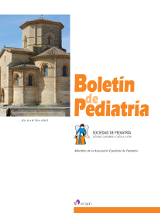Hiperfrecuentación en Pediatría: ¿Se trata de una verdadera necesidad?
D. Mata Zubillaga, M. Fernández Miaja, M.V. Cobo Pacios
Bol. Pediatr. 2015; 55 (234): 243 - 246
Introducción. Frecuentemente detectamos que una pequeña parte de la población genera un gran número de consultas. Esto supone un importante consumo de recursos. Objetivos. 1) Describir la importancia de la hiperfrecuentación y su impacto económico. 2) Indagar las características de aquellos más hiperfrecuentadores. 3) Averiguar si existía alguna causa relacionada con su salud. Material y métodos. Estudio observacional, descriptivo, transversal. Se incluyeron los menores de 14 años. Se registró número total de visitas y número de pacientes que realizaron cada número de visitas. Se definió hiperfrecuentación como la media de visitas más una desviación estándar. El coste por consulta está valorado en 20,89 €. En aquellos con ≥ 20 visitas revisamos el historial. Resultados. Incluimos 875 pacientes (5.206 visitas; 5,95 ± 5,55 visitas/paciente). Hiperfrecuentador fue aquel con más de 12 visitas. Hubo 125 hiperfrecuentadores (14%), realizando 2.098 visitas (40%). Acudieron ≥ 20 veces 26 sujetos (3%), generando 637 visitas (12%). La edad media fue 26,5 ± 18,9 meses. Se encontró correlación negativa entre edad y visitas a hospital (coeficiente -0,26). Padecían ESRL 13. Acudieron a urgencias 1,46 ± 1,5 veces e ingresaron 0,42 ± 0,7 veces. Hubo 6 prematuros (EG 27,8 ± 0,5 semanas; PRN 825,0 ± 253,6 g). Realizaron 29,3 ± 7,0 visitas (21-38). Se encontró correlación negativa entre EG y visitas (coeficiente -0,3), urgencias hospitalarias(-0,27) e ingresos (-0,37). Conclusiones. 1) Los sujetos hiperfrecuentadores son un 14% de la población y ocupan el 40% de las consultas. El ahorro potencial anual que supondría una asistencia similar a la media sería 31.721 €. 2) Asimismo sobrecargan los Servicios de Urgencias. 3) Presentan similar morbilidad que el resto de la población. La prematuridad parece influir, aunque no justifica el fenómeno.
Frequent users in Pediatrics: Is this a real need?
Introduction. We frequently detect that a small part of the population generates a large number of visits. This
accounts for a significant use of resources.
Objectives: 1) Describe the importance of frequent users and its economic impact. 2) Investigate the characteristics of those having the most frequent visits. 3) Discover if there is
any health-related cause.
Material and methods. Cross-sectional, descriptive and observational study. Children under 14 years of age were included. Total number of visits and number of patients who made each number of visits were recorded. Frequent use was defined as the mean visits plus one standard deviation. Cost per visit is calculated at 20.89 €. We reviewed the clinical record for those having ≥ 20 visits.
Results. We included 875 patients (5,206 visits; 5.95 ± 5.55 visits/patient). High level of visitors were those with more than 12 visits. There were 125 high level visitors (14%), who made 2,098 visits (40%). A total of 26 subjects (3%) came ≥ 20 time, generating 637 visits (12%). Mean age was 26.5 ± 18.9 months. There was a negative correlation between age and visits to the hospital (coefficient -0.26). Thirteen had recurrent
wheezing episodes in early childhood (RWE-infancy). They came to the emergency service 1.46 ± 1.5 times and were hospitalized 0.42 ± 0.7 times. There were 6 premature babies (gestational age 27.8 ± 0.5 weeks; PRN 825.0 ± 253.6 g). They made 29.3 ± 7.0 visits (21-38). Negative correlation was found between GA and visits (coefficient -0.3), hospital emergencies (-0.27) and admissions (-0.37).
Conclusions: 1) Subjects with high frequency of visits accounts for 14% of the population and use 40% of the visits. The potential annual saving that would be obtained with care similar to the mean would be 31,721 €. 2) In addition, they overload the Emergency Service. 3) They have similar morbidity as the rest of the population. Prematurity may play a role, although it does not justify the phenomenon.
Artículo completo (PDF) (62 kb.)
